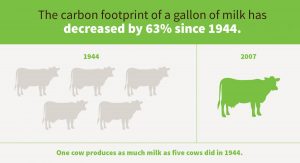 The National Dairy FARM Program has released its Environmental Stewardship Continuous Improvement Reference Manual in cooperation with the Innovation Center for U.S. Dairy. Released in celebration of Earth Day, the guide provides a comprehensive suite of on-farm management practices to reduce a farm’s environmental footprint and improve its profitability.
The National Dairy FARM Program has released its Environmental Stewardship Continuous Improvement Reference Manual in cooperation with the Innovation Center for U.S. Dairy. Released in celebration of Earth Day, the guide provides a comprehensive suite of on-farm management practices to reduce a farm’s environmental footprint and improve its profitability.
Specifically, the manual features a detailed explanation of the FARM Environmental Stewardship (ES) module, as well as strategies to reduce on-farm greenhouse gas (GHG) emissions in various areas of farm management, including feed, manure, energy, forage, and animal health.
“FARM Environmental Stewardship helps us tell our story in a measurable, science-based way while providing business value that is both financially and environmentally beneficial,” said Mike McCloskey, Chairman of the NMPF Environmental Committee, Innovation Center for U.S. Dairy Environmental Stewardship Committee and co-founder of fairlife, LLC. “The FARM Environmental Stewardship Continuous Improvement Reference Manual provides a resource that aggregates existing science and technology that can help us drive continuous improvement, all while tracking our progress in a way we can share with dairy customers.”
FARM ES is a voluntary, farmer-driven tool that helps producers expand their sustainability efforts by using a limited amount of data about their farm. The module is based on a life-cycle assessment (LCA) of fluid milk conducted by the Applied Sustainability Center at the University of Arkansas, incorporating existing data from more than 500 dairy farms across the United States. Launched in February, FARM ES is the third of the FARM Program’s three silos, including Animal Care and Antibiotic Stewardship.
The FARM ES reference manual was developed by FARM and includes previous work completed by the Innovation Center. The World Wildlife Fund (WWF) led an independent review of the manual using a panel of subject matter experts.
“In an increasingly resource scarce world, we need to produce more food on the current amount of land, with less inputs and environmental impacts,” said Sandra Vijn, director for markets and food at WWF. “FARM ES will support U.S. dairy farmers in continuously identifying better management practices for environmental stewardship. That is why WWF works with NMPF, the industry and dairy experts to ensure the program produces the best resources and solutions for farmers in terms of environmental sustainability.”
This manual further demonstrates the dairy industry’s culture of continuous improvement, the focus of the FARM Program. Since 1944, the carbon footprint of a gallon of milk has decreased by 63 percent – a leading example of farmers’ dedication to being good stewards of natural resources.
In addition to the manual, the FARM Program has developed an extensive library of resources regarding the program and environmental stewardship. It can be found on the Environmental Stewardship page of the FARM website. Questions about the program can be directed toward Ryan Bennett.
Share this Post










